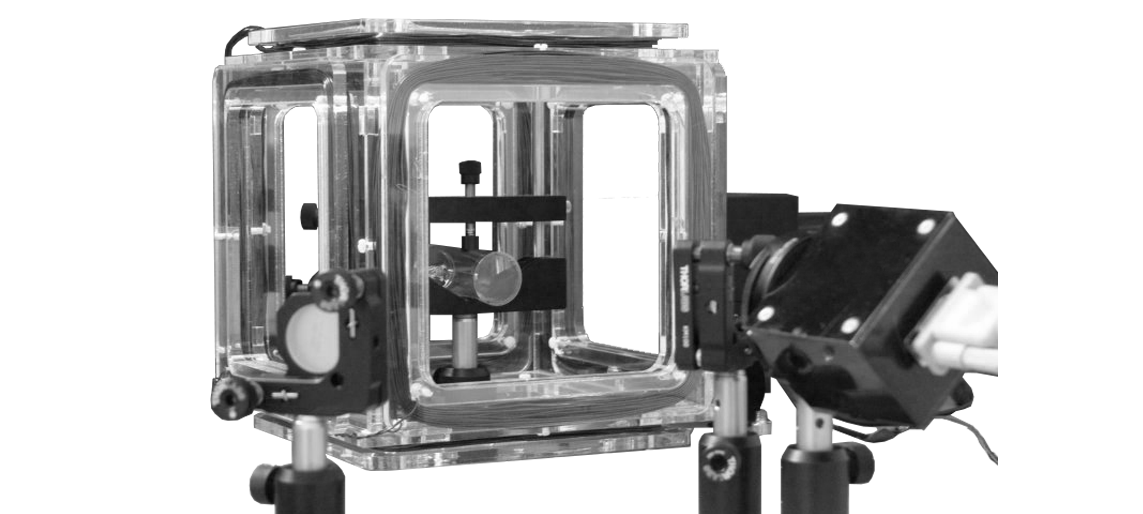Laser spectroscopy kit will let you to:
- See the structure of the D2 transition,
52S1/2 -> 52P3/2 in Rubidium - Demonstrate absorption spectroscopy
– which reveals the hyperfine structure of a ground state - Perform saturated spectroscopy,
– to learn hyperfine structure of an excited state - Determine frequency scale,
– where laser is tuned with a Michelson interferometer - Demonstrate the Zeeman effect
– by measurement of magnetorotation about absorption lines – Maculoso-Corbino Effect - Perform isotopic analysis of Rubidium
– by absorbance measurement of 85Rb and 87Rb isotopes
Our ECDL Spectroscopy Kit includes:
- External Cavity Diode Laser in Littrow configuration,
with the beam rotation at tuning cancelled - Complete laser driver set in the euro subrack housing, consisting of the following modules:
– Current stabilized from 0 to 200 mA(other ranges available), 30nA RMS noise, max. 20ppm / K drift
– Multi-turn knob for adjusting current, red LED laser-on indicator
– On-board adjustable current limit
– Diode current high frequency modulation (up to 100MHz) with 50-ohm BNC connector
– Additional BNC connector configurable as input: current modulation 1mA/V; current setting (knob override) 20 mA / V; output of laser photodiode current or laser current noise monitor
- Laser temperature stabilisation block
– Temperature setting by multi-turn knob,
– Very high stability – 3mK RMS (15 min)
– Bipolar TEC control (heating and cooling) with a maximum current of 4 A and a voltage of 6 V with current limit ability (separate for cooling and heating),
– Separately adjustable PID parameters by mounting potentiometers on the front panel module - Tuning controller (piezo) block:
– Triangle tuning waveform generator with a frequency from 0.1 to 200Hz, additional continuous adjust over one decade range
– Adjustable amplitude and offset allows to convenient adjust tuning range
– Adjustable current-piezo scan coupling, allowing to avoid the laser mode hopping
– Output voltage range ±12V, short-circuit proof
– Timing output to trigger the oscilloscope - Photodiodes/polarimeter interface block:
– Two-channel BNC input and output allows subtracting the DC component of the input signals and obtaining the sum and difference of these signals (useful for differential absorption measurement)
– Connector for connecting the polarimeter and BNC outputs for sum and difference signal,
– The differential signal from the polarimeter has switchable gain. - Monitor block with two LCD meters showing:
– Laser current,
– Photodiode current
– Piezo voltage,
– One external slot for other uses (e.g. optional wavelength stabilization system),
– Current laser temperature,
– Temperature set point (thermistor resistance),
– Difference between current temperature and the set point,
– TEC module current.
3. Post-mountable small light detectors
– With silicon photodiode and BNC output with sensitivity 1-1000V/mW (replacement resistor)
4. Post-mountable polarimeter
– With crystal polarizer and two photodiodes with high-speed and low-noise preamplifier
– Polarimeter can be conveniently rotated in the mount with angle scale
5. The system of three pairs of Helmholtz coils, which allows you to:
– To adjust the intensity of the magnetic field in three orthogonal axes
– Dedicated power supply allowing to set the current in each coil pair separately
– Possibility of external current modulation in all three axes
– Maximum current is ±3 A
6. Rubidium cell with a natural isotope abundance
7. Mirrors, beam-splitters, optical wedge and a quarter waveplate
8. Posts mounts for optical elements
9. Aluminum breadboard with M6 holes for fixing





